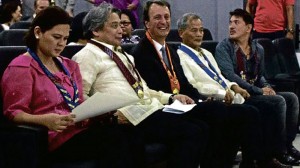
DAVAO City Mayor Sarah Duterte, FDCP chair Briccio Santos, French Ambassador to the Philippines Gilles Garachon, Danny Brocka and filmmaker Brillante Mendoza were special guests during the recent Davao cinematheque inaugural.
DAVAO CITY – The Film Development Council of the Philippines (FDCP) received a 35-mm projector from the SM Group of Companies at the recent inauguration of the Davao cinematheque.
It was “a symbolic proof of the growing partnership between the government and the private sector in advancing the cause of Philippine movies,” according to FDCP chair Briccio Santos.
The projector was personally handed to Santos by Ed Tejerero, senior vice president for SM Cinemas.
A nat’l booking service
Santos earlier announced that the Council would be partnering with SM to create a national booking service (NBS) with the goal of coming up with an effective marketing and distribution system.
Santos added that the Davao cinematheque was one of the FDCP’s centerpiece projects. A cinematheque is a screening venue for classic and art-house movies, ideally with a film archive.
“It would not have been possible without the support and cooperation of local government units (LGUs),” he pointed out.
An agreement between the FDCP and the city government of Davao, headed by Mayor Sarah Duterte, has made possible the use of the space and building for the cinematheque.
A lifetime commitment
“At first glance, this structure may not be as luxurious and imposing as the grand palaces of Philippine and world cinema, but it definitely symbolizes a lifetime commitment of the Philippine government to advance the cause of the local motion picture industry to revive and energize it, and make it as strong and robust as it used to be in years gone by,” Santos said in his opening speech.
Other cinematheques
Santos shared that the FDCP’s first fully-functioning cinematheque opened in Baguio in September 2011. He added that others were being set up in Iloilo, Zamboanga, and Marawi City.
Since July 3, two films by National Artist for Film Lino Brocka and several European films— from the Czech Republic, France, Italy and Spain—have already been screened at the Davao cinematheque.
More than an art-house cinema
“The cinematheque aspires to function not merely in the traditional sense of an art-house cinema, but even beyond that,” Santos stressed. “It is a vital part of the Sineng Pambansa of the FDCP, whose dedicated mission is to ‘bring Filipino films to Filipinos.’”
Santos explained that the cinematheque was designed as “an alternative, accessible, and affordable venue for classic and contemporary Filipino films, as well as for state-of-the-art foreign movies sourced through the FDCP’s Film Cultural Exchange Program with foreign embassies in Manila.”
A center for filmmaking
Aside from this, Santos said the cinematheques would also function as a center for workshops and symposiums on directing, scriptwriting, editing, cinematography, and other aspects of filmmaking, “with the primary objective of supporting and empowering the emerging new generation of Filipino filmmakers.”
“We’d like to think that the opening of the new cinematheque augurs well for the emerging potential role of Davao City as one of the leading centers of culture and the cinematic arts, not only in the Philippines, but throughout the Southeast Asian region as well,” the FDCP chief pointed out.
Another highlight of the inauguration was the unveiling of Brocka’s statue by sculptor Jonas Roces. The 1st Sineng Pambansa National Film Festival was held here from June 29 to July 3.
Email mcruz@inquirer.com.ph